Laser Line Polarizing Beamsplitter Cubes
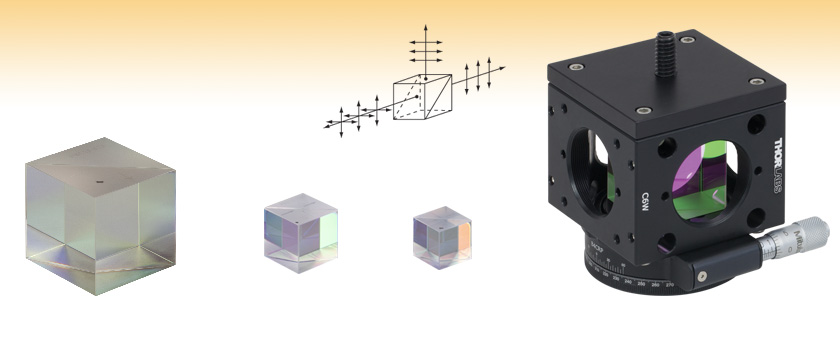
- Extinction Ratio: Tp:Ts > 3000:1
- Six Laser Line Wavelengths Available
- 10 mm, 1/2", and 1" Cubes Available
PBS25-532
532 nm, 1" Cube
PBS12-1550
1550 nm, 1/2" Cube
1" Beamsplitter Cube Shown in C6W Cage Cube with B4CRP Rotation Platform and B6C Clamp
PBS10-780
780 nm, 10 mm Cube

Please Wait
| Common Specifications | |
|---|---|
| Material | UV Fused Silicaa |
| Extinction Ratiob | TP:TS > 3000:1 |
| Transmission Efficiencyc,d | TP > 95% |
| Reflection Efficiencyc,d | RS > 99.5% |
| Transmitted Beam Deviationc | 0° ± 5 arcmin |
| Reflected Beam Deviationc | 90° ± 5 arcmin |
| Clear Aperture | >80% of Length and Width |
Features
- Design Wavelengths: 532 nm, 633 nm, 780 nm, 980 nm, 1064 nm, or 1550 nm
- 10 mm, 1/2" (12.7 mm), or 1" (25.4 mm) Polarizing Beamsplitter Cubes
- Reflectance at Each Surface <0.25%
- Extinction Ratio: TP:TS > 3000:1
- Top of Cube Engraved with Item # and Arrows Indicating Light Path
Thorlabs' Laser Line Polarizing Beamsplitting Cubes are offered in 10 mm, 1/2", and 1" sizes. These cubes are available with six different AR coatings for popular laser line wavelengths: 532 nm, 633 nm, 780 nm, 980 nm (1" size only), 1064 nm, or 1550 nm. These cubes separate the s- and p-polarization components of a beam by reflecting the
s-polarization component at the dielectric beamsplitter coating, while allowing the p-polarization component to pass. For the highest polarization extinction ratio, use the transmitted beam, which offers an extinction ratio of TP:TS > 3000:1.
These beamsplitting cubes are made from two UV Fused Silica glass prisms. A dielectric beamsplitter coating is deposited on the hypotenuse of one of the two prisms that make up the cube. Then, cement is used to bind the two prism halves together. Finally, an AR coating is applied on all four sides of the cube, as indicated in the diagram below and to the right. The dot on the top of the cube indicates the prism with the beamsplitter coating. Light can be input into any of the polished faces to separate the S and P polarizations. One possible orientation is engraved on the top of the cube.
Please refer to the BS Cube Mounting tab above for information on mounting options and compatibility. Alternatively, the 1" cubes are available pre-mounted in cage cubes. Custom beamsplitter cubes can be ordered by contacting Tech Support. For high power applications, we also offer high-power polarizing beamsplitter cubes. For a wider wavelength range, please see our broadband polarizing beamsplitter cubes.
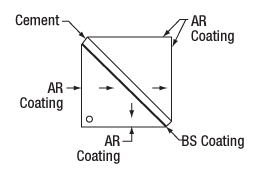
Cube Beamsplitter Diagram
(Coating and Cement Layer Not to Scale)
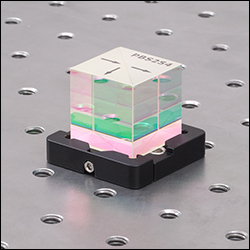
Click to Enlarge
1" Beamsplitter Cube Mounted Directly to Breadboard
Using BSH1 Prism Mount
(Refer to the BS Cube Mounting tab for Other Options)
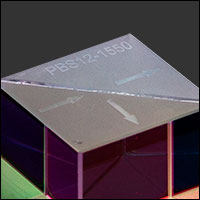
Click to Enlarge
The engraving on the top of the optic indicates the Item #
and one of the possible beam paths.
The graphs below give the transmission curves for each laser line polarizing beamsplitter cube. The dashed line on each graph indicates the design wavelength of the cube.
| Damage Threshold Specifications | ||
|---|---|---|
| Design Wavelength (Item # Suffix) |
Damage Threshold | |
| 532 nm (-532) | CWa | 100 W/cm (532 nm, Ø1.000 mm) |
| Pulsed | 2 J/cm2 (532 nm, 10 ns, 10 Hz, Ø0.470 mm) | |
| 1064 nm (-1064) | CWa | 1.5 kW/cm (1070 nm, Ø1.012 mm) |
| Pulsed | 2 J/cm2 (1064 nm, 10 ns, 10 Hz, Ø0.517 mm) | |
| 1550 nm (-1550) | CWa | 1.5 kW/cm (1540 nm, Ø0.087 mm) |
Damage Threshold Data for Thorlabs' Laser Line Polarizing Beamsplitter Cubes
The specifications to the right are measured data for a selection of Thorlabs' laser line polarizing cube beamsplitters.
Laser Induced Damage Threshold Tutorial
The following is a general overview of how laser induced damage thresholds are measured and how the values may be utilized in determining the appropriateness of an optic for a given application. When choosing optics, it is important to understand the Laser Induced Damage Threshold (LIDT) of the optics being used. The LIDT for an optic greatly depends on the type of laser you are using. Continuous wave (CW) lasers typically cause damage from thermal effects (absorption either in the coating or in the substrate). Pulsed lasers, on the other hand, often strip electrons from the lattice structure of an optic before causing thermal damage. Note that the guideline presented here assumes room temperature operation and optics in new condition (i.e., within scratch-dig spec, surface free of contamination, etc.). Because dust or other particles on the surface of an optic can cause damage at lower thresholds, we recommend keeping surfaces clean and free of debris. For more information on cleaning optics, please see our Optics Cleaning tutorial.
Testing Method
Thorlabs' LIDT testing is done in compliance with ISO/DIS 11254 and ISO 21254 specifications.
First, a low-power/energy beam is directed to the optic under test. The optic is exposed in 10 locations to this laser beam for 30 seconds (CW) or for a number of pulses (pulse repetition frequency specified). After exposure, the optic is examined by a microscope (~100X magnification) for any visible damage. The number of locations that are damaged at a particular power/energy level is recorded. Next, the power/energy is either increased or decreased and the optic is exposed at 10 new locations. This process is repeated until damage is observed. The damage threshold is then assigned to be the highest power/energy that the optic can withstand without causing damage. A histogram such as that below represents the testing of one BB1-E02 mirror.

The photograph above is a protected aluminum-coated mirror after LIDT testing. In this particular test, it handled 0.43 J/cm2 (1064 nm, 10 ns pulse, 10 Hz, Ø1.000 mm) before damage.

| Example Test Data | |||
|---|---|---|---|
| Fluence | # of Tested Locations | Locations with Damage | Locations Without Damage |
| 1.50 J/cm2 | 10 | 0 | 10 |
| 1.75 J/cm2 | 10 | 0 | 10 |
| 2.00 J/cm2 | 10 | 0 | 10 |
| 2.25 J/cm2 | 10 | 1 | 9 |
| 3.00 J/cm2 | 10 | 1 | 9 |
| 5.00 J/cm2 | 10 | 9 | 1 |
According to the test, the damage threshold of the mirror was 2.00 J/cm2 (532 nm, 10 ns pulse, 10 Hz, Ø0.803 mm). Please keep in mind that these tests are performed on clean optics, as dirt and contamination can significantly lower the damage threshold of a component. While the test results are only representative of one coating run, Thorlabs specifies damage threshold values that account for coating variances.
Continuous Wave and Long-Pulse Lasers
When an optic is damaged by a continuous wave (CW) laser, it is usually due to the melting of the surface as a result of absorbing the laser's energy or damage to the optical coating (antireflection) [1]. Pulsed lasers with pulse lengths longer than 1 µs can be treated as CW lasers for LIDT discussions.
When pulse lengths are between 1 ns and 1 µs, laser-induced damage can occur either because of absorption or a dielectric breakdown (therefore, a user must check both CW and pulsed LIDT). Absorption is either due to an intrinsic property of the optic or due to surface irregularities; thus LIDT values are only valid for optics meeting or exceeding the surface quality specifications given by a manufacturer. While many optics can handle high power CW lasers, cemented (e.g., achromatic doublets) or highly absorptive (e.g., ND filters) optics tend to have lower CW damage thresholds. These lower thresholds are due to absorption or scattering in the cement or metal coating.

LIDT in linear power density vs. pulse length and spot size. For long pulses to CW, linear power density becomes a constant with spot size. This graph was obtained from [1].

Pulsed lasers with high pulse repetition frequencies (PRF) may behave similarly to CW beams. Unfortunately, this is highly dependent on factors such as absorption and thermal diffusivity, so there is no reliable method for determining when a high PRF laser will damage an optic due to thermal effects. For beams with a high PRF both the average and peak powers must be compared to the equivalent CW power. Additionally, for highly transparent materials, there is little to no drop in the LIDT with increasing PRF.
In order to use the specified CW damage threshold of an optic, it is necessary to know the following:
- Wavelength of your laser
- Beam diameter of your beam (1/e2)
- Approximate intensity profile of your beam (e.g., Gaussian)
- Linear power density of your beam (total power divided by 1/e2 beam diameter)
Thorlabs expresses LIDT for CW lasers as a linear power density measured in W/cm. In this regime, the LIDT given as a linear power density can be applied to any beam diameter; one does not need to compute an adjusted LIDT to adjust for changes in spot size, as demonstrated by the graph to the right. Average linear power density can be calculated using the equation below.

The calculation above assumes a uniform beam intensity profile. You must now consider hotspots in the beam or other non-uniform intensity profiles and roughly calculate a maximum power density. For reference, a Gaussian beam typically has a maximum power density that is twice that of the uniform beam (see lower right).
Now compare the maximum power density to that which is specified as the LIDT for the optic. If the optic was tested at a wavelength other than your operating wavelength, the damage threshold must be scaled appropriately. A good rule of thumb is that the damage threshold has a linear relationship with wavelength such that as you move to shorter wavelengths, the damage threshold decreases (i.e., a LIDT of 10 W/cm at 1310 nm scales to 5 W/cm at 655 nm):

While this rule of thumb provides a general trend, it is not a quantitative analysis of LIDT vs wavelength. In CW applications, for instance, damage scales more strongly with absorption in the coating and substrate, which does not necessarily scale well with wavelength. While the above procedure provides a good rule of thumb for LIDT values, please contact Tech Support if your wavelength is different from the specified LIDT wavelength. If your power density is less than the adjusted LIDT of the optic, then the optic should work for your application.
Please note that we have a buffer built in between the specified damage thresholds online and the tests which we have done, which accommodates variation between batches. Upon request, we can provide individual test information and a testing certificate. The damage analysis will be carried out on a similar optic (customer's optic will not be damaged). Testing may result in additional costs or lead times. Contact Tech Support for more information.
Pulsed Lasers
As previously stated, pulsed lasers typically induce a different type of damage to the optic than CW lasers. Pulsed lasers often do not heat the optic enough to damage it; instead, pulsed lasers produce strong electric fields capable of inducing dielectric breakdown in the material. Unfortunately, it can be very difficult to compare the LIDT specification of an optic to your laser. There are multiple regimes in which a pulsed laser can damage an optic and this is based on the laser's pulse length. The highlighted columns in the table below outline the relevant pulse lengths for our specified LIDT values.
Pulses shorter than 10-9 s cannot be compared to our specified LIDT values with much reliability. In this ultra-short-pulse regime various mechanics, such as multiphoton-avalanche ionization, take over as the predominate damage mechanism [2]. In contrast, pulses between 10-7 s and 10-4 s may cause damage to an optic either because of dielectric breakdown or thermal effects. This means that both CW and pulsed damage thresholds must be compared to the laser beam to determine whether the optic is suitable for your application.
| Pulse Duration | t < 10-9 s | 10-9 < t < 10-7 s | 10-7 < t < 10-4 s | t > 10-4 s |
|---|---|---|---|---|
| Damage Mechanism | Avalanche Ionization | Dielectric Breakdown | Dielectric Breakdown or Thermal | Thermal |
| Relevant Damage Specification | No Comparison (See Above) | Pulsed | Pulsed and CW | CW |
When comparing an LIDT specified for a pulsed laser to your laser, it is essential to know the following:

LIDT in energy density vs. pulse length and spot size. For short pulses, energy density becomes a constant with spot size. This graph was obtained from [1].
- Wavelength of your laser
- Energy density of your beam (total energy divided by 1/e2 area)
- Pulse length of your laser
- Pulse repetition frequency (prf) of your laser
- Beam diameter of your laser (1/e2 )
- Approximate intensity profile of your beam (e.g., Gaussian)
The energy density of your beam should be calculated in terms of J/cm2. The graph to the right shows why expressing the LIDT as an energy density provides the best metric for short pulse sources. In this regime, the LIDT given as an energy density can be applied to any beam diameter; one does not need to compute an adjusted LIDT to adjust for changes in spot size. This calculation assumes a uniform beam intensity profile. You must now adjust this energy density to account for hotspots or other nonuniform intensity profiles and roughly calculate a maximum energy density. For reference a Gaussian beam typically has a maximum energy density that is twice that of the 1/e2 beam.
Now compare the maximum energy density to that which is specified as the LIDT for the optic. If the optic was tested at a wavelength other than your operating wavelength, the damage threshold must be scaled appropriately [3]. A good rule of thumb is that the damage threshold has an inverse square root relationship with wavelength such that as you move to shorter wavelengths, the damage threshold decreases (i.e., a LIDT of 1 J/cm2 at 1064 nm scales to 0.7 J/cm2 at 532 nm):

You now have a wavelength-adjusted energy density, which you will use in the following step.
Beam diameter is also important to know when comparing damage thresholds. While the LIDT, when expressed in units of J/cm², scales independently of spot size; large beam sizes are more likely to illuminate a larger number of defects which can lead to greater variances in the LIDT [4]. For data presented here, a <1 mm beam size was used to measure the LIDT. For beams sizes greater than 5 mm, the LIDT (J/cm2) will not scale independently of beam diameter due to the larger size beam exposing more defects.
The pulse length must now be compensated for. The longer the pulse duration, the more energy the optic can handle. For pulse widths between 1 - 100 ns, an approximation is as follows:

Use this formula to calculate the Adjusted LIDT for an optic based on your pulse length. If your maximum energy density is less than this adjusted LIDT maximum energy density, then the optic should be suitable for your application. Keep in mind that this calculation is only used for pulses between 10-9 s and 10-7 s. For pulses between 10-7 s and 10-4 s, the CW LIDT must also be checked before deeming the optic appropriate for your application.
Please note that we have a buffer built in between the specified damage thresholds online and the tests which we have done, which accommodates variation between batches. Upon request, we can provide individual test information and a testing certificate. Contact Tech Support for more information.
[1] R. M. Wood, Optics and Laser Tech. 29, 517 (1998).
[2] Roger M. Wood, Laser-Induced Damage of Optical Materials (Institute of Physics Publishing, Philadelphia, PA, 2003).
[3] C. W. Carr et al., Phys. Rev. Lett. 91, 127402 (2003).
[4] N. Bloembergen, Appl. Opt. 12, 661 (1973).
In order to illustrate the process of determining whether a given laser system will damage an optic, a number of example calculations of laser induced damage threshold are given below. For assistance with performing similar calculations, we provide a spreadsheet calculator that can be downloaded by clicking the button to the right. To use the calculator, enter the specified LIDT value of the optic under consideration and the relevant parameters of your laser system in the green boxes. The spreadsheet will then calculate a linear power density for CW and pulsed systems, as well as an energy density value for pulsed systems. These values are used to calculate adjusted, scaled LIDT values for the optics based on accepted scaling laws. This calculator assumes a Gaussian beam profile, so a correction factor must be introduced for other beam shapes (uniform, etc.). The LIDT scaling laws are determined from empirical relationships; their accuracy is not guaranteed. Remember that absorption by optics or coatings can significantly reduce LIDT in some spectral regions. These LIDT values are not valid for ultrashort pulses less than one nanosecond in duration.

A Gaussian beam profile has about twice the maximum intensity of a uniform beam profile.
CW Laser Example
Suppose that a CW laser system at 1319 nm produces a 0.5 W Gaussian beam that has a 1/e2 diameter of 10 mm. A naive calculation of the average linear power density of this beam would yield a value of 0.5 W/cm, given by the total power divided by the beam diameter:

However, the maximum power density of a Gaussian beam is about twice the maximum power density of a uniform beam, as shown in the graph to the right. Therefore, a more accurate determination of the maximum linear power density of the system is 1 W/cm.
An AC127-030-C achromatic doublet lens has a specified CW LIDT of 350 W/cm, as tested at 1550 nm. CW damage threshold values typically scale directly with the wavelength of the laser source, so this yields an adjusted LIDT value:

The adjusted LIDT value of 350 W/cm x (1319 nm / 1550 nm) = 298 W/cm is significantly higher than the calculated maximum linear power density of the laser system, so it would be safe to use this doublet lens for this application.
Pulsed Nanosecond Laser Example: Scaling for Different Pulse Durations
Suppose that a pulsed Nd:YAG laser system is frequency tripled to produce a 10 Hz output, consisting of 2 ns output pulses at 355 nm, each with 1 J of energy, in a Gaussian beam with a 1.9 cm beam diameter (1/e2). The average energy density of each pulse is found by dividing the pulse energy by the beam area:

As described above, the maximum energy density of a Gaussian beam is about twice the average energy density. So, the maximum energy density of this beam is ~0.7 J/cm2.
The energy density of the beam can be compared to the LIDT values of 1 J/cm2 and 3.5 J/cm2 for a BB1-E01 broadband dielectric mirror and an NB1-K08 Nd:YAG laser line mirror, respectively. Both of these LIDT values, while measured at 355 nm, were determined with a 10 ns pulsed laser at 10 Hz. Therefore, an adjustment must be applied for the shorter pulse duration of the system under consideration. As described on the previous tab, LIDT values in the nanosecond pulse regime scale with the square root of the laser pulse duration:

This adjustment factor results in LIDT values of 0.45 J/cm2 for the BB1-E01 broadband mirror and 1.6 J/cm2 for the Nd:YAG laser line mirror, which are to be compared with the 0.7 J/cm2 maximum energy density of the beam. While the broadband mirror would likely be damaged by the laser, the more specialized laser line mirror is appropriate for use with this system.
Pulsed Nanosecond Laser Example: Scaling for Different Wavelengths
Suppose that a pulsed laser system emits 10 ns pulses at 2.5 Hz, each with 100 mJ of energy at 1064 nm in a 16 mm diameter beam (1/e2) that must be attenuated with a neutral density filter. For a Gaussian output, these specifications result in a maximum energy density of 0.1 J/cm2. The damage threshold of an NDUV10A Ø25 mm, OD 1.0, reflective neutral density filter is 0.05 J/cm2 for 10 ns pulses at 355 nm, while the damage threshold of the similar NE10A absorptive filter is 10 J/cm2 for 10 ns pulses at 532 nm. As described on the previous tab, the LIDT value of an optic scales with the square root of the wavelength in the nanosecond pulse regime:

This scaling gives adjusted LIDT values of 0.08 J/cm2 for the reflective filter and 14 J/cm2 for the absorptive filter. In this case, the absorptive filter is the best choice in order to avoid optical damage.
Pulsed Microsecond Laser Example
Consider a laser system that produces 1 µs pulses, each containing 150 µJ of energy at a repetition rate of 50 kHz, resulting in a relatively high duty cycle of 5%. This system falls somewhere between the regimes of CW and pulsed laser induced damage, and could potentially damage an optic by mechanisms associated with either regime. As a result, both CW and pulsed LIDT values must be compared to the properties of the laser system to ensure safe operation.
If this relatively long-pulse laser emits a Gaussian 12.7 mm diameter beam (1/e2) at 980 nm, then the resulting output has a linear power density of 5.9 W/cm and an energy density of 1.2 x 10-4 J/cm2 per pulse. This can be compared to the LIDT values for a WPQ10E-980 polymer zero-order quarter-wave plate, which are 5 W/cm for CW radiation at 810 nm and 5 J/cm2 for a 10 ns pulse at 810 nm. As before, the CW LIDT of the optic scales linearly with the laser wavelength, resulting in an adjusted CW value of 6 W/cm at 980 nm. On the other hand, the pulsed LIDT scales with the square root of the laser wavelength and the square root of the pulse duration, resulting in an adjusted value of 55 J/cm2 for a 1 µs pulse at 980 nm. The pulsed LIDT of the optic is significantly greater than the energy density of the laser pulse, so individual pulses will not damage the wave plate. However, the large average linear power density of the laser system may cause thermal damage to the optic, much like a high-power CW beam.
Thorlabs offers a variety of mounting solutions for our beamsplitter cubes. The mounts below allow our cubes to be post-mounted or integrated into our 16 mm or 30 mm cage systems. Post-mountable solutions are compatible with our Ø1/2" Posts as well as Ø1" Posts with 8-32 (M4) taps.
| Post-Mountable Mounts for Beamsplitter Cubes | ||||||||
|---|---|---|---|---|---|---|---|---|
| Click Photo to Enlarge (Cubes Not Included) |
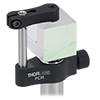 |
 |
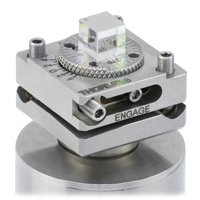 |
 |
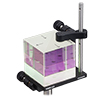 |
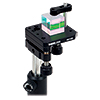 |
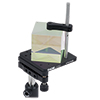 |
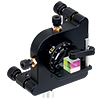 |
| Item # | PCM(/M) | BSH10(/M) BSH05(/M) BSH20(/M) BSH1(/M) BSH2(/M) |
FBTB(/M) | KM100PM(/M) | KM200PM(/M) | KM100B(/M) | KM200B(/M) | K6XS |
| Required Accessories | Base: PCMP(/M) | - | - | Clamp: PM3(/M) or PM4(/M) |
Clamp: PM3(/M) or PM4(/M) |
Clamp: PM3(/M) or PM4(/M) |
Clamp: PM3(/M) or PM4(/M) |
Adapter: K6A1(/M) |
| Mounting Options | Ø1/2" Posts | Ø1/2" Postsa,b | Ø1/2" Posts | Ø1/2" Posts | Ø1/2" Posts | Ø1/2" Posts | Ø1/2" Posts | Ø1/2" Posts |
| Features | Compact | Compact | Glue-In Mount with Precision Tip, Tilt, and Rotation | Tip and Rotation | Tip and Rotation | Kinematic Mount | Kinematic Mount | 6-Axis Mount |
| Compatible Beamsplitter Cube Size(s) |
Up to 20 mm | 10 mm, 1/2", 20 mm, 1", 2" |
5 mm | Up to 20 mmc Up to 1" d |
Up to 20 mmc Up to 1" d Up to 2" e |
Up to 20 mmc Up to 1" d |
Up to 20 mmc Up to 1" d Up to 2" e |
5 mm 10 mm 1/2" |
| Cage System Mounts for Beamsplitter Cubes | |||||||||
|---|---|---|---|---|---|---|---|---|---|
| Click Photo to Enlarge (Cubes Not Included) |
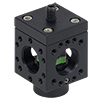 |
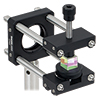 |
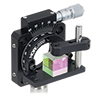 |
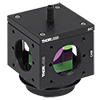 |
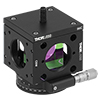 |
 |
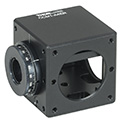 |
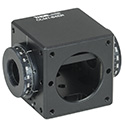 |
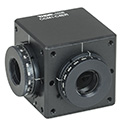 |
| Item # | Cage Cube: SC6W |
ARV1 | CRM1(/M) or CRM1P(/M) | Cage Cube: C4W or C6W a | CCM1-4ER(/M) | CCM1-A4ER(/M) | CCM1-B4ER(/M) | CCM1-C4ER(/M) | |
| Required Accessories | Clamp: SB6C, Platform: SPM2 |
- | Adapter: K6A1(/M) |
Clamp: B6C, Platform: B3C(/M) or B4C(/M) |
Clamp: B6C, Platform: B3CR(/M) or B4CRP(/M) |
- | - | - | - |
| Mounting Options |
16 mm Cage Systems | 30 mm Cage Systems | 30 mm Cage Systems or Ø1/2" Posts | 30 mm Cage Systems | 30 mm Cage Systems or Ø1/2" Posts | ||||
| Features | Compact | Compact | Rotation Mount | Fixed or Kinematic Platforms | Rotation Platforms | - | One Rotation Mount | Two Rotation Mounts @ 180° | Two Rotation Mounts @ 90° |
| Compatible Beamsplitter Cube Size(s) |
10 mm | 5 mm 10 mm |
5 mm 10 mm 1/2" |
1/2" 20 mm 1" |
5 mm (with BS5CAM Adapter) 10 mm (with BS10CAM Adapter) 1/2" (with BS127CAM Adapter) 20 mm (with BS20CAM Adapter) 1" (Directly Compatible) |
||||
Beamsplitter Selection Guide
Thorlabs' portfolio contains many different kinds of beamsplitters, which can split beams by intensity or by polarization. We offer plate and cube beamsplitters, though other form factors exist, including pellicle and birefringent crystal. For an overview of the different types and a comparison of their features and applications, please see our overview. Many of our beamsplitters come in premounted or unmounted variants. Below is a complete listing of our beamsplitter offerings. To explore the available types, wavelength ranges, splitting/extinction ratios, transmission, and available sizes for each beamsplitter category, click More [+] in the appropriate row below.Plate Beamsplitters
| Non-Polarizing Plate Beamsplitters |
|---|
| Polarizing Plate Beamsplitters |
|---|
Cube Beamsplitters
| Non-Polarizing Cube Beamsplitters |
|---|
| Polarizing Cube and Polyhedron Beamsplitters |
|---|
| Type | Wavelength Range | Extinction Ratio (TP:TS) |
Typical Transmission | AR Coated Faces |
Cemented | Available Cube/ Polyhedron Side Length |
| Standard: Unmounted 16 mm Cage Cube 30 mm Cage Cube |
420 - 680 nm | >1000:1 | Yes | Yes | Unmounted: 5 mm, 10 mm, 1/2", 20 mm, 1", and 2" Mounted: 20 mm in a 16 mm Cage Cube, 1" in a 30 mm Cage Cube |
|
| 620 - 1000 nm | ||||||
| 700 - 1300 nm | ||||||
| 900 - 1300 nm | ||||||
| 1200 - 1600 nm | ||||||
| Wire Grid: Unmounted 30 mm Cage Cube |
400 - 700 nm | >1000:1 (AOI: 0° - 5°) >100:1 (AOI: 0° - 25°) |
P-Pol. S-Pol. |
Yes | Yes | Unmounted: 1" Mounted: 20 mm in a 16 mm Cage Cube, 1" in a 30 mm Cage Cube |
| High-Power Laser Line: Unmounted 30 mm Cage Cube |
355 nm | >2000:1 | No | Unmounted: 1/2" and 1" Mounted: 1" in a 30 mm Cage Cube |
||
| 405 nm | ||||||
| 532 nm | ||||||
| 633 nm | ||||||
| 780 - 808 nm | ||||||
| 1064 nm | ||||||
| Laser Line: Unmounted 30 mm Cage Cube |
532 nm | >3000:1 | Yes | Yes | Unmounted: 10 mm, 1/2", and 1" Mounted: 1" in a 30 mm Cage Cube |
|
| 633 nm | ||||||
| 780 nm | ||||||
| 980 nm | ||||||
| 1064 nm | ||||||
| 1550 nm | ||||||
| High-Power, Broadband, High Extinction Ratio Polarizers | 700 - 1100 nm | >1000:1 (700 - 1100 nm) >5000:1 (750 - 1000 nm) >10 000:1 (800 - 900 nm) |
Yes | No | 12.7 mm (Input/Output Face, Square) |
|
| 900 - 1300 nm | >1000:1 (900 - 1300 nm) >10 000:1 (900 - 1250 nm) >100 000:1 (980 - 1080 nm) |
10.0 mm and 5.0 mm (Input/Output Face, Square) |
||||
| Laser-Line Variable | 532 nm | Not Specified | No Graph Available | Yes | Yes | Assembly Mounted in a 30 mm Cage Cube |
| 633 nm | ||||||
| 780 nm | ||||||
| 1064 nm | ||||||
| 1550 nm | ||||||
| Broadband Variable | 420 - 680 nm | Not Specified | No Graph Available | Yes | Yes | Assembly Mounted in a 30 mm Cage Cube |
| 690 - 1000 nm | ||||||
| 900 - 1200 nm | ||||||
| 1200 - 1600 nm | ||||||
| Circular Polarizer/Beamsplitter |
532 nm | Not Specified | No Graph Available | Yes | Yes | Assembly Mounted in a 30 mm Cage Cube |
| 633 nm | ||||||
| 780 nm | ||||||
| 1064 nm | ||||||
| 1550 nm |
Pellicle Beamsplitters
| Non-Polarizing Pellicle Beamsplitters |
|---|
Crystal Beamsplitters
| Polarizing Crystal Beamsplitters |
|---|
Other
| Other Beamsplitters |
|---|
| Posted Comments: | |
user
(posted 2022-03-21 14:10:18.203) It would be nice if you gave the polarization extinction ratio for the reflected port, i.e. Rs:Rp. How much p polarization gets reflected compared to s polarization? cdolbashian
(posted 2022-03-25 03:25:44.0) Thank you for contacting Thorlabs. We have reached out to you via email to see if we have the record of your PBS test data. Joseph Vance
(posted 2020-10-16 12:19:20.69) Hi,
I would be interested in cubes that are AR coated for
852 nm, the cesium D2 line. Since 780 is included for rubidium D2, I would imagine there is also widespread interest in 852nm. YLohia
(posted 2020-11-03 09:40:30.0) Hello, thank you for contacting Thorlabs. Custom versions of these beamsplitters can be requested by emailing techsupport@thorlabs.com. We will discuss the possibility of offering this directly. spassky
(posted 2018-10-03 20:06:24.4) i can't get the raw data of 633 nm. All the raw data i can download is of 532 nm. YLohia
(posted 2018-10-03 09:13:24.0) Hello, the file includes raw data for all wavelengths (532, 633, 780, 980, 1064, and 1550 nm). You would have to select the appropriately titled sheet in Excel. |
Polarizer Selection Guide
Thorlabs offers a diverse range of polarizers, including wire grid, film, calcite, alpha-BBO, rutile, and beamsplitting polarizers. Collectively, our line of wire grid polarizers offers coverage from the visible range to the beginning of the Far-IR range. Our nanoparticle linear film polarizers provide extinction ratios as high as 100 000:1. Alternatively, our other film polarizers offer an affordable solution for polarizing light from the visible to the Near-IR. Next, our beamsplitting polarizers allow for use of the reflected beam, as well as the more completely polarized transmitted beam. Finally, our alpha-BBO (UV), calcite (visible to Near-IR), rutile (Near-IR to Mid-IR), and yttrium orthovanadate (YVO4) (Near-IR to Mid-IR) polarizers each offer an exceptional extinction ratio of 100 000:1 within their respective wavelength ranges.
To explore the available types, wavelength ranges, extinction ratios, transmission, and available sizes for each polarizer category, click More [+] in the appropriate row below.
| Wire Grid Polarizers |
|---|
| Film Polarizers |
|---|
| Beamsplitting Polarizers |
|---|
| Polarizer Type | Wavelength Range | Extinction Ratio | Transmissiona | Available Sizes |
| Polarizing Plate Beamsplitters | 405 nm | >10 000:1 | Ø1" and 25 mm x 36 mm | |
| 532 nm | ||||
| 633 nm | ||||
| 780 nm | ||||
| 808 nm | ||||
| 1030 nm | ||||
| 1064 nm | ||||
| 1310 nm | ||||
| 1550 nm | ||||
| Polarizing Bandpass Filters | 355 nm +6 nm / -9 nm | 1 000 000:1 | 25.2 mm x 35.6 mm | |
| Broadband Polarizing Beamsplitter Cubes (Unmounted, 16 mm Cage Cube, or 30 mm Cage Cube) |
420 nm - 680 nm | 1000:1e | 5 mm, 10 mm, 1/2", 20 mmf, 1"f, and 2" | |
| 620 nm - 1000 nm | ||||
| 700 nm - 1300 nm | ||||
| 900 nm - 1300 nm | ||||
| 1200 nm - 1600 nm | ||||
| Wire Grid Polarizing Beamsplitter Cubes (Unmounted or 30 mm Cage Cube) |
400 nm - 700 nm | >1 000:1 (AOI: 0° - 5°) >100:1 (AOI: 0° - 25°) |
P-Pol. S-Pol. |
1"f |
| Laser-Line Polarizing Beamsplitter Cubes (Unmounted or 30 mm Cage Cube) |
532 nm | 3000:1 | 10 mm, 1/2", 1"f | |
| 633 nm | ||||
| 780 nm | ||||
| 980 nm | 1"f | |||
| 1064 nm | 10 mm, 1/2", 1"f | |||
| 1550 nm | ||||
| High-Power Laser-Line Polarizing Beamsplitter Cubes (Unmounted or 30 mm Cage Cube) | 355 nm | 2000:1 | 1/2" and 1"f | |
| 405 nm | ||||
| 532 nm | ||||
| 633 nm | ||||
| 780 - 808 nm | ||||
| 1064 nm | ||||
| High-Power, Broadband, High Extinction Ratio Polarizers | 700 nm - 1100 nm | > 1000:1 (700 - 1100 nm) > 5000:1 (750 - 1000 nm) > 10 000:1 (800 - 900 nm) |
12.7 mm (Input/Output Face, Square) |
|
| 900 nm - 1300 nm | >1000:1 (900 - 1300 nm) >10 000:1 (900 - 1250 nm) >100 000:1 (980 - 1080 nm) |
10 mm and 5 mm (Input/Output Face, Square) |
||
| Calcite Beam Displacers | 350 nmg - 2.3 µm (Uncoated) | - | 10 mmb (Clear Aperture, Square) |
|
| Yttrium Orthovanadate (YVO4) Beam Displacers | 488 nm - 3.4 µm (Uncoated) | - | >3 mm x 5 mm Ellipseh (Clear Aperture) |
|
| 2000 nm (V Coated) |
| alpha-BBO Polarizers |
|---|
| Calcite Polarizers |
|---|
| Quartz Polarizers |
|---|
| Magnesium Fluoride Polarizers |
|---|
| Yttrium Orthovanadate (YVO4) Polarizers |
|---|
| Rutile Polarizers |
|---|

| Item # | PBS10-532 | PBS10-633 | PBS10-780 | PBS10-1064 | PBS10-1550 | |
|---|---|---|---|---|---|---|
| Design Wavelength | 532 nm | 633 nm | 780 nm | 1064 nm | 1550 nm | |
| Cube Size | 10.0 mm x 10.0 mm x 10.0 mm | |||||
| Clear Aperture | >8.0 mm x 8.0 mm | |||||
| Transmitted Wavefront Error |
<λ/4 at 633 nm over Ø8.0 mm | |||||
| AR Coating Reflectance (0° AOI) |
Rabs < 0.25% @ 532 nm |
Rabs < 0.25% @ 633 nm |
Rabs < 0.25% @ 780 nm |
Rabs < 0.25% @ 1064 nm |
Rabs < 0.25% @ 1550 nm |
|
| Damage Thresholds |
CWa | 100 W/cm @ 532 nm (Ø1.000 mm) |
- | - | 1.5 kW/cm @ 1070 nm (Ø1.012 mm) |
1.5 kW/cm @ 1540 nm (Ø0.087 mm) |
| Pulsed | 2 J/cm2 @ 532 nm (10 ns, 10 Hz, Ø0.470 mm) |
- | - | 2 J/cm2 @ 1064 nm (10 ns, 10 Hz, Ø0.517 mm) |
- | |
| Surface Quality | 40-20 Scratch-Dig | |||||

| Item # | PBS12-532 | PBS12-633 | PBS12-780 | PBS12-1064 | PBS12-1550 | |
|---|---|---|---|---|---|---|
| Design Wavelength | 532 nm | 633 nm | 780 nm | 1064 nm | 1550 nm | |
| Cube Size | 12.7 mm x 12.7 mm x 12.7 mm | |||||
| Clear Aperture | >10.2 mm x 10.2 mm | |||||
| Transmitted Wavefront Error |
<λ/4 at 633 nm over Ø10.2 mm | |||||
| AR Coating Reflectance (0° AOI) |
Rabs < 0.25% @ 532 nm |
Rabs < 0.25% @ 633 nm |
Rabs < 0.25% @ 780 nm |
Rabs < 0.25% @ 1064 nm |
Rabs < 0.25% @ 1550 nm |
|
| Damage Thresholds |
CWa | 100 W/cm @ 532 nm (Ø1.000 mm) |
- | - | 1.5 kW/cm @ 1070 nm (Ø1.012 mm) |
1.5 kW/cm @ 1540 nm (Ø0.087 mm) |
| Pulsed | 2 J/cm2 @ 532 nm (10 ns, 10 Hz, Ø0.470 mm) |
- | - | 2 J/cm2 @ 1064 nm (10 ns, 10 Hz, Ø0.517 mm) |
- | |
| Surface Quality | 40-20 Scratch-Dig | |||||

| Item # | PBS25-532 | PBS25-633 | PBS25-780 | PBS25-980 | PBS25-1064 | PBS25-1550 | |
|---|---|---|---|---|---|---|---|
| Design Wavelength | 532 nm | 633 nm | 780 nm | 980 nm | 1064 nm | 1550 nm | |
| Cube Size | 25.4 mm x 25.4 mm x 25.4 mm | ||||||
| Clear Aperture | >20.32 mm x 20.32 mm | ||||||
| Transmitted Wavefront Error |
<λ/4 at 633 nm over Ø20.32 mm | ||||||
| AR Coating Reflectance (0° AOI) |
Rabs < 0.25% @ 532 nm |
Rabs < 0.25% @ 633 nm |
Rabs < 0.25% @ 780 nm |
Rabs < 0.25% @ 980 nm |
Rabs < 0.25% @ 1064 nm |
Rabs < 0.25% @ 1550 nm |
|
| Damage Thresholds |
CWa | 100 W/cm @ 532 nm (Ø1.000 mm) |
- | - | - | 1.5 kW/cm @ 1070 nm (Ø1.012 mm) |
1.5 kW/cm @ 1540 nm (Ø0.087 mm) |
| Pulsed | 2 J/cm2 @ 532 nm (10 ns, 10 Hz, Ø0.470 mm) |
- | - | - | 2 J/cm2 @ 1064 nm (10 ns, 10 Hz, Ø0.517 mm) |
- | |
| Surface Quality | 40-20 Scratch-Dig | ||||||
 Products Home
Products Home














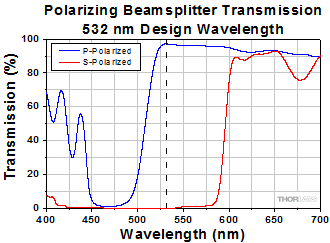
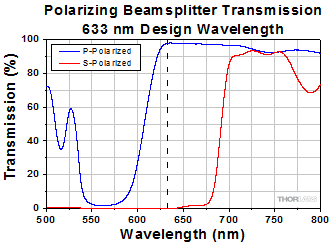
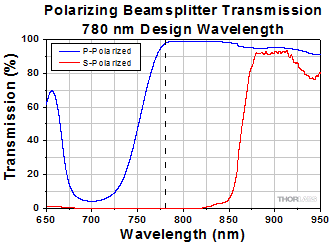
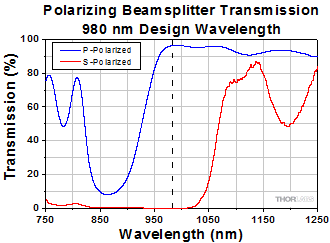
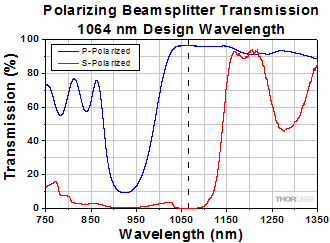
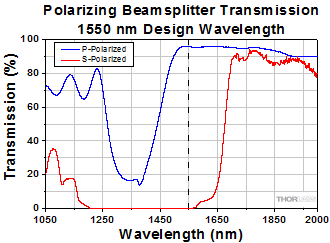

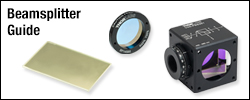
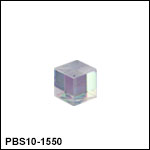
 Zoom
Zoom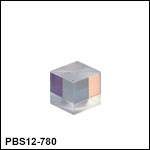
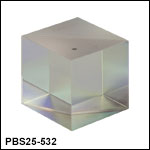
 Unmounted Laser Line Beamsplitter Cubes
Unmounted Laser Line Beamsplitter Cubes